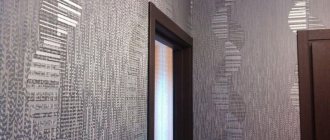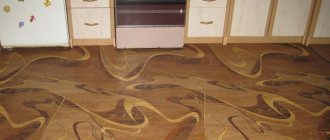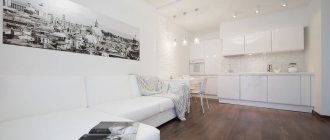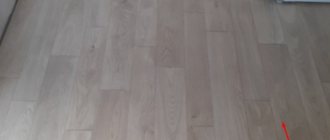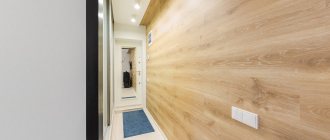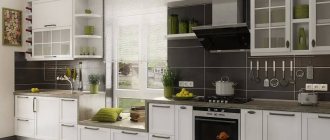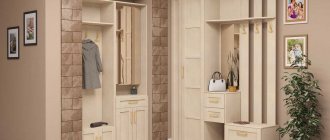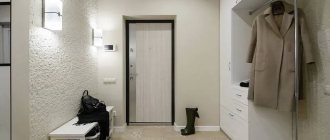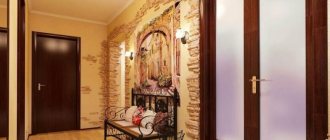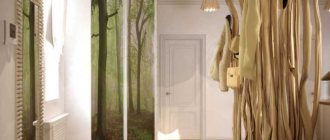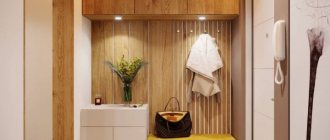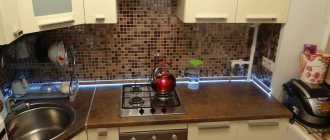Renovating the entire apartment gradually leads to the question: how to choose the right linoleum for the hallway? This is the most popular hallway flooring. It is moisture-resistant, withstands mechanical damage and abrasion from shoes, and is easily washed off from dirt. In addition to the quality of the material, you need to pay attention to its color and pattern, how suitable it is for the interior of the corridor. In this article we will consider the main parameters for choosing linoleum in the hallway.
Linoleum is a publicly available, democratic material that has been used to cover floors for the second century.
Tips for choosing and purchasing linoleum
Let's look at how to choose the right linoleum for your home. 1. First of all, let’s trust our sense of smell: the presence of a pungent odor indicates the low quality of the coating and that it contains additives that are harmful to health. High-quality natural and synthetic linoleum does not smell of anything. In addition, good linoleum should not have a greasy sheen, the pattern should be distinct and look natural, the optimal number of layers is at least five. 2. The width of the covering should, as a rule, match the size of the room. But you need to take it with a reserve - for adjusting the pattern, trimming the panel at the joints. When making calculations, it is necessary to take into account the presence of thresholds, niches for batteries, and other protrusions in the room. 3. It is recommended to buy the coating not on the market, but preferably in a heated room. It’s also more convenient to check its quality in a store. 4. It is worth checking the coating for compliance with safety standards. The material that has passed a special examination is marked accordingly, and the seller must have a hygiene certificate. 5. You need to check the quality in a rolled out form to see if there are any waves or bumps on the surface, or areas where the top film is peeling off. These indicators indicate a defect; such coverage cannot be purchased; existing unevenness will not be smoothed out in any way. 6. When buying the same linoleum in several rooms, it is better to purchase it in one piece. But at the same time, it is necessary to first calculate whether it will be possible to bring a long roll into the room and whether it will be possible to transport it through narrow openings and stairs. 7. Folding the panels in half is strictly prohibited. Do not stick tape to the front surface, as it will leave a sticky residue that is difficult to remove. Roll the linoleum with the front side inward, and if it is rolled with the front side out, the roll must be wrapped in protective film. 8. When choosing a coating, preference should be given to linoleum, which has a special protective layer. This linoleum is easy to clean and will retain its beautiful appearance for a long time. 9. If possible, samples of linoleum should be inspected in the room where it will be laid. This is convenient for more accurately selecting the appropriate tone in the interior (cold or warm linoleum), because doing this from memory is not so easy. 10. All purchased linoleum must be from the same batch, since different batches sometimes differ in color, even when their articles are completely the same. All of the above tips, recommendations and explanations will help you make a successful purchase of linoleum from any price segment.
Selection based on operational features
Another important question is how to choose quality linoleum for an apartment. When purchasing flooring, focus on the following criteria:
- compliance with the microclimate of the room;
- protective properties (taking into account the specifics of the room in which the finishing is carried out);
- resistance to mechanical loads;
- insulation capabilities;
- additional properties: antistatic, antibacterial coating, etc.
One of the most important criteria is the thickness of the material. What thickness of linoleum is better is up to you to decide.
If this is a walkable corridor or kitchen, where we are forced to constantly move during the cooking process, it is better to choose a coating of reliable density (up to 4 mm with a protective layer 0.25 mm thick). And when decorating a living room or bedroom with heated floors, choose linoleum for an apartment without a thick base (up to 1.5 mm thick).
Advice: when deciding which linoleum to choose, take into account the area of the room. Ideally, such a coating should not have joints or seams.
How to choose the right linoleum for an apartment, taking into account its protective properties and resistance to the microclimate of the rooms? High-quality material must withstand exposure to sunlight, moisture, steam, not be subject to combustion in a fire and not crack due to temperature changes.
The easiest way to determine the quality of linoleum is to test the material, but, as a rule, all properties of coatings are indicated on the packaging.
When choosing which linoleum is best for your home, you can turn a blind eye to its antistatic properties. But if you are decorating rooms such as a nursery, this property is a must. Moreover, it must be environmentally friendly linoleum for an apartment with a thickness of at least 3 mm.
Important! Linoleum with copper strips will have the best antistatic effect. High-quality linoleum should spread comfortably, so check in advance whether its structure is damaged when rolled up and transported. As an alternative, you can choose tiled linoleum, which consists of many individual small-sized fragments
As an alternative, you can choose tiled linoleum, which consists of many individual small-sized fragments
High-quality linoleum should spread comfortably, so check in advance whether its structure is damaged when rolled up and transported. As an alternative, you can choose tiled linoleum, which consists of many individual small-sized fragments.
The floor covering must withstand different types of cleaning. Therefore, make sure that the linoleum does not deteriorate when applying household chemicals. Better yet, opt for a coating that does not retain dust and dirt. Consultants will tell you how to choose good linoleum with these properties.
There are many more criteria for choosing linoleum for an apartment, but one of the most important will be its harmonious appearance. Therefore, let's figure out what design options manufacturers can offer us.
Wall decoration in a small hallway. Wallpaper as an option for a small corridor
When thinking about the design of the corridor, you need to select finishing materials in advance. If the walls are smooth, then it is better to paint them. Acrylic, alkyd or water-based paints are suitable for this. An ultra-modern option is polyurethane or latex paint, which are durable, stain-resistant and easy to maintain.
A small hallway can be increased in volume by cleverly thinking through the lighting and decorating it in a common style with the apartment.
As an option for a small corridor, decorative plaster is suitable, which looks more impressive than paint. When there are side surfaces, the easiest way is to cover them with PVC and MDF panels, but at the same time take into account air humidity.
A variety of modern materials for wall decoration helps to hide wall imperfections, “play” with light, create a stylish corridor design and visually increase its area. The table shows different types of wallpaper for the walls in the hallway, indicating their pros and cons.
It is important to maintain the functionality of the hallway
| Type of wallpaper | Advantages | Flaws |
| Paper | Eco-friendly material, highly breathable, affordable price | Easily damaged, lose color, not resistant to moisture, short-lived |
| Vinyl | Durable, resistant to mechanical damage, retain color for a long time, provide high noise insulation | They have poor air permeability, which threatens the development of fungus, and they emit toxic substances (formaldehyde) |
| Non-woven | They allow air and steam to pass through, hide uneven surfaces, withstand dry and wet cleaning, do not fade in the sun, are fire resistant | Instability to mechanical damage, accumulates dust on the surface, which is dangerous due to the emergence of dust mites, is expensive |
| Liquid | They have no joints, absorb sounds, retain heat, hide unevenness. | They dry for a long time after application to walls (up to 48 hours), and are destroyed by moisture. |
| Textile | Invisible seams, high heat and sound insulation, fire resistant | Absorption of odors, impossibility of cleaning, accumulation of dust on the surface, high cost |
| Jute | Strong, durable, wear-resistant, environmentally friendly, do not fade in the sun, easy to clean | High price |
| Linen | Can be dry cleaned, do not fade in the sun, made from natural materials | High cost, complexity of the procedure for gluing to walls |
| Silk | Look very original, durable, do not fade in the sun | High cost, custom made |
| Velor | Original texture, strength, environmental friendliness | High cost, difficult to clean |
| Cork | Wear-resistant, breathable, does not attract dust, made from environmentally friendly materials | Sloppy joints, inability to hide wall imperfections, difficult subsequent repairs of cork-coated walls |
| Metallized | Wear-resistant, light-resistant, easy to clean dry or wet | Fragile, do not allow air to pass through, formation of strong reflections in bright light, high cost |
Choosing a substrate for linoleum
Before laying linoleum, you should think about the substrate. The underlay is a heat and sound insulating material that is placed under linoleum or laminate. In addition, it smoothes out floor defects. There are several types of substrate:
- Cork
- Jute
- Linen
- Foamed
Cork backing for linoleum
Cork backing is made from crushed tree bark, without the use of synthetic products. The material is well suited for heat and sound insulation. However, one should take into account the fact that the cork backing is deformed under heavy pieces of furniture.
Jute backing for linoleum
Jute backing is made from natural fibers. During production, the jute substrate undergoes special treatment, making it resistant to fire or mold.
Linen backing for linoleum
Linen backing, like jute, is made from natural fiber. This material is good because it maintains ventilation between the floor and linoleum.
Foamed backing for linoleum
Experts do not recommend using this type of substrate, as it quickly loses its shape and does not perform its functions.
Today, experts agree that a backing for linoleum is, in principle, not particularly necessary. The only exception is the use of a substrate when choosing baseless linoleum. And all other types of linoleum are made on a jute, fabric or polyvinyl chloride base, so there is no need for an additional base.
How to choose
To choose high-quality flooring for your room, follow some recommendations:
- During the cold season, it is better to purchase linoleum in a store rather than on the market, since it tends to deform under the influence of low temperatures. In addition, it is more convenient to inspect the canvas for defects in the store.
- To find out what size the product you are purchasing should be, measure the area of your room and leave allowances of a few centimeters on all sides.
Pay attention to the smell. A high-quality product should not emit a “fragrance.” This is unacceptable for a recreation area. This type of linoleum, such as marmoleum, cannot be ignored. It is made from natural materials and has two positive qualities at once: absence of odor and antibacterial effect.
And this is very important if there are children in your house, because the living room often becomes their play area. A product with an anti-slip layer is ideal for a living room if it does not have carpeting.
One thing should also be taken into account. If you choose linoleum not for an apartment, but for a sports, concert, or assembly hall, then the selection criteria are slightly different. The main thing we have to rely on is that all of the above classrooms have a high degree of traffic, that is, they are subject to large mechanical loads: walking, rearranging furniture, and the impact of heels. Therefore, the linoleum covering for these halls must, first of all, be durable.
Briefly about the main thing
Linoleum has remained a practical and versatile coating in residential design for decades. There are various material options on the market intended for household, commercial and special uses. Among its characteristics, wear resistance (abrasion resistance) is significant. It is different for different types of coating, which is reflected in the markings.
Linoleum in the right color palette will become the basis for high-quality interior design. You can choose a color to match or contrast with the wall decoration. You should also take into account the style of the room, the color of furniture, textiles and accessories. In modern design, light-colored linoleum is especially popular; it is used in the decor of any room.
Linoleum for the corridor: how to choose
There are several color options for flooring for the interior of the corridor.
Blue, Tiffany color and its combinations are the ideal color for the hallway, which visually expands the space, associating with open space.
This material is very resistant to abrasion, moisture, mechanical damage, dirt, and is easy to care for.
Yellow, sand, cream tones also look good in the hallway, enhancing the illumination of the room.
When choosing, you need to pay attention to a number of factors, from appearance to brand and country of production. Orange, terracotta, brick color - suitable for a classic hallway style, preferably with wood imitation
Orange, terracotta, brick color - suitable for the classic style of the hallway, preferably with imitation wood.
With proper care, the coating has a long service life.
Green, marsh, grassy shades are universal for any type of room. Depending on the shade, it will help to narrow and expand the space, suitable for the Provence style.
Depending on the type, its thermal insulation characteristics are superior to laminate or tile.
Brown, woody color is a symbol of peace, comfort and good quality. Ideal for flooring in a classic style.
Easy installation, which is important for those who decide to carry out repair work themselves.
Black shade - this tone should only be used in combination with another shade, for example in a checkerboard pattern. Pairs well with white, turquoise and yellow.
It does not require an additional protective layer.
White color - gives a feeling of lightness and airiness to the room; the ideal shade is bleached oak. The gray floor goes beautifully with the wenge-colored doors. Light shades combine with modern style.
Advantages include softness, elasticity and strength.
Dark floors will suit the hallway, where there is excellent lighting, otherwise it will create a feeling of lack of light. Light-colored furniture looks advantageous with dark floors. With plain wallpaper and light-colored furniture, you can lay rich, bright linoleum, the main thing is not to overdo it with colorful accessories. Scratches and dirt are not visible on such a floor.
The coating is resistant to acids.
If the apartment has a narrow and small corridor, then a lined covering will do. It should be laid across long walls. Linoleum with small tiles also looks good in a small hallway. A floor with imitation wood will create the effect of a high-quality and expensive coating.
Linoleum has high sound and heat insulation properties.
Material with imitation stone or tiles goes well with the classic design of the hallway; this option is worth choosing for a large room. Linoleum with unusual and colorful patterns in different colors is an excellent hall design solution for people who adore originality. Geometric patterns are becoming the choice of people who value classics and rigor.
The most budget option of all floor coverings.
You can experiment with the colors of the floors, choosing the best option for the interior of the corridor.
Self-leveling decorative floor
Quite a new material, rarely used in hallways. This situation is explained by the high cost and technological complexity of application. Decorative self-leveling floors in hallways are found only in exclusive luxury apartments.
Self-leveling floor with a pattern in the hallway
This is an excellent solution for hallways, but only if the specific type is chosen correctly
What should you consider?
Floor base. The hallways may have a concrete slab (the best option) or a wooden floor. In the second case, you will have to make a cement-sand screed. This not only increases the time and cost of installing the flooring, but also reduces the height of the hallway
It must be taken into account that the floors in all rooms should be located at the same level; if the floor in the hallway is higher, this causes problems. Self-leveling floor for a corridor or hallway
Availability of utilities under the floor
Electrical cables and other engineering equipment are often placed under the floors in the hallway. When the floor is flooded, access to these elements will become inaccessible. Special preliminary measures should be taken and specialists should be consulted. Conditions for performing work. If renovations are being done in the hallway of a residential apartment, then only the same compositions are selected. For new construction, the list of permitted floors increases.
The main stages of pouring a self-leveling floor
The choice of floor is also influenced by the conditions of its use: is there heating under it, are there direct sunlight, is it possible for aggressive chemical compounds to enter
The maximum load, which depends on the parameters of the furniture placed in the hallway, should also be taken into account. A correctly selected and filled self-leveling floor will decorate not only the hallway, but the entire apartment
Self-leveling floor in the hallway
In the world of flooring, this is a completely unique option. Thanks to the new development, it can have an impressive appearance in the hallway design. The floor with it can optionally turn into the seabed, into a blooming garden and other fascinating things. All this is realized using 3D technologies and photo printing. The self-leveling floor can imitate any material, as in the photo below. It is also attractive that the decor is under a thick protective layer. This means that it will not wear out or fade over time.
Another advantage of this floor that is important for the hallway is that it is 100% waterproof. There are no traces left on the surface from heavy furniture, sharp hairpins, pebbles caught under heels, etc. The fact is that its structure is very dense, so the surface is hard. The self-leveling floor in the hallway meets all practical requirements. But its price cannot be said to be low. But if the room is not large, it will not take very much money to install it.
Waterproof floor coverings
The flooring material in the hallway should also be easy to install, so that in case of damage it can also be easily dismantled. For rooms with increased load, more modern PVC-based coatings have appeared.
- Quartz Vinyl Tile
- Engineered Vinyl Plank
- Floors based on ceramic chips and talc
All these species are united by a number of qualities that are absent in others. The main ones are the highest degree of wear resistance - class 43. Such things are even found in shopping centers. And the second important point is water resistance. If you pour water on them and do not remove it, even after a week nothing will swell. The water will evaporate rather than damage such floors. The floor in the hallway, photo of which is presented below, is made of vinyl.
In addition, you don’t have to make an island at the entrance in the hallway; you can cover the entire apartment with such floor coverings, including the bathroom and kitchen.
Design options
In order for the design of the hallway to be not just beautiful, but spectacular, it is necessary to take into account the characteristics of the room. With the help of floor design, you can visually change not only its size, but also the character of the interior.
If you want to see a fancy mosaic at the entrance to your home, it is better to choose porcelain stoneware or glass tiles. They are moisture resistant and easy to clean.
Do you want to enliven the restrained interior of the hallway? Decorate the floor with panels. It can be made from both parquet and marble, as well as porcelain tiles. You can use ready-made design solutions, which are offered in abundance when purchasing in a store, or come up with your own unique design.
Pros and cons of each material
After a brief overview of the main types of finishing materials for the hallway, we will dwell in more detail on each of the listed options.
Linoleum
One of its undeniable advantages is the price. Compared to many other coatings, the cost of linoleum seems to be more affordable, and therefore more suitable for budget repairs.
It is a very soft and noise-absorbing material. It is quite tensile and abrasion resistant, non-flammable, and therefore fireproof. It is easy to care for - when wet cleaning there are practically no water stains left on it. Among the disadvantages are its chemical origin. In addition, marks from furniture, heels and other sharp objects remain on it.
Self-leveling floor
One of the most important advantages of this option over other types of finishing is its absolute waterproofness. In addition, such a floor is often a real work of art - absolutely any design can be depicted on it.
Another undeniable advantage of this material is its exceptional hardness. You can safely dance on it and move furniture - there are no marks left on it. And the drawing will not lose its brightness even after several decades.
However, this floor covering is also not perfect. Its high cost puts it out of reach for many. Its composition is also not ideal - the mixture consists of chemical elements. Another big disadvantage of self-leveling flooring is that it is uncomfortable for the human body - the coating is cold to the touch, so you can only walk on it with shoes.
Marble
Just like self-leveling flooring, marble is a fairly hard and durable material. It is also not afraid of moisture, scratches and also does not lose color for decades. Only unlike the first one, it is of natural origin.
Disadvantages also include high cost and difficulty in processing - working with marble requires special tools and professional skills. This stone is considered soft, so if a heavy object falls, it can damage the integrity of the floor slab. In addition, marble is afraid of acid-containing substances - they leave dark spots on it.
Tiled ceramic floor
Ceramics is a natural material; it is absolutely hypoallergenic and waterproof. It retains heat well, which is why tile floors are often used as the top finish for heated floors. The tiles are easy to clean and withstand cleaning with cleaning agents.
However, it is not without its shortcomings. If the coating has a glossy texture, there is a high risk of slipping. If the surface is too rough, dirt may be retained in its depressions, which is then difficult to wash out.
Combined floor
Ceramics looks very good in combination with wood and wood-like textures. In this case it is parquet or laminate. This floor has virtually no drawbacks, unless you don’t like different textures. But even in this case, you can choose materials that are similar in design.
Ceramic tiles and porcelain tiles
This type of coating is impervious to moisture, easy to maintain and wear-resistant.
Floor tiles (aka tiles) are a popular material for decorating hallways. In order for the floor to last a long time, you need to choose tiles with wear resistance class 3-4 and a non-smooth surface.
According to the degree of resistance to chemical attack, class AC tiles are used in domestic premises.
The range of colors, patterns, sizes and textures is huge. The tiles imitate marble, granite, wood, laminate and other materials.
Porcelain tiles are stronger and more expensive than ceramic tiles, painted over the entire thickness (the color will remain the same even after 10 years of active use), and are not afraid of frost.
There are fewer color and texture options than ceramics. Because of its strength, porcelain tiles can last 50 years, but for installation in a residential building such a service life is useless.
A significant disadvantage of these coatings is the cold surface. If you are used to walking barefoot at home, then a warm floor will solve this problem.
What shades and colors are there?
When choosing this coating, special attention should be paid to color. Modern technologies allow manufacturers to produce a wide variety of linoleum models, with many shades and design patterns.
Among all the variety there is both colored and plain flooring material.
When making a choice, it is worth remembering that the overall perception of the interior directly depends on the correctly chosen color. Linoleum in cool shades can visually enlarge the space, while warm colors create coziness.
The type of pattern is also important when selecting a product.
The fine pattern adds extra dimension to the room, while the beautiful geometric abstraction beautifully accents the surrounding furniture and accessories. For rooms with low levels of light, a light flooring material would be an ideal option.
White and black and white linoleum, which can be either glossy or matte, looks quite stylish. The original decoration for the home is green, red, blue and light blue flooring material.
The lilac-colored coating looks very elegant, creating a unique atmosphere and is most often used in public places. Classic brown linoleum and moss colors look quite presentable and can be used in both residential and public spaces.
Models of this flooring that imitate natural materials are very popular. Linoleum imitating wood, stone or ceramic tiles is considered especially popular. Products for boards resembling parquet or laminate are in great demand.
Each version of this flooring has its own purpose. The assortment includes a wide variety of linoleum models, among which anyone can choose the most suitable copy, based on the characteristics of the room, as well as personal wishes and needs.
Nuances of choosing material and design features of the floor in the hallway
No matter how beautiful this or that material may look, first of all, when choosing it for the hallway, you need to focus on qualities such as strength and moisture resistance. The requirements for the practicality of a material for finishing the floor in a hallway are much higher than for materials for finishing other rooms in the apartment. After all, the hallway is the most visited room, so the flooring must be resistant to abrasion, moisture and dirt, and also easy to clean. Let's look at the most popular materials for flooring.
Linoleum in the hallway
Perhaps the most common floor covering used in the hallway.
Linoleum is the most common flooring used in hallways
Its popularity is explained by:
- high strength;
- moisture resistance;
- unpretentiousness in care;
- variety of colors.
There are several types of linoleum coverings on sale:
The components for the production of natural linoleum are wood chips, cork bark, resin, chalk and linseed oil.
Artificial linoleum is a worthy replacement for natural
The only drawback of such flooring is the rather high price (up to $20 per square meter), and such material also requires periodic rubbing with a special mastic. This article will tell you more about linoleum for the home.
Artificial linoleum is a worthy replacement for natural linoleum, and its cost is much lower.
Linoleum made from synthetic materials, unlike its natural counterpart, has a wider range of colors, not limited only to natural shades.
The disadvantage of ceramic tiles is their coldness, which requires the installation of a heated floor system
The main criterion when choosing linoleum for a hallway is strength, which depends on the thickness of the top layer. The thicker it is, the longer the coating will last.
Using linoleum, you can imitate many surfaces, for example, wood, parquet, the seabed and even metal. Linoleum can be combined with other materials, for example, with wood, by covering the area near the front door with the coating described, and the rest of the space with wood. It can also be combined with tiles; in this case, the tiles are laid near the threshold.
How to care
There are a number of care rules that allow you to hide uneven colors and also maintain the original appearance of linoleum for many years.
After laying such a floor covering, you must adhere to some rules during its operation:
- Immediately after installation, the surface of the material should be covered with a special mastic, which will create an additional protective layer from mechanical stress and increase the level of wear resistance.
- Before you begin wet cleaning, the product must be vacuumed to remove dust and dirt from the surface, preventing scratches.
- It is recommended to wash linoleum with a soft mop and cool water with the addition of special detergents.
- To remove severe stains, you need to use only liquid products, but not abrasive ones.
- A chilled potato decoction or linseed oil, which should be used to wipe the surface several times a month, will help maintain the shine of glossy coatings.
Material composition
Linoleum also has significant differences in the composition of the materials used:
- Thus, household linoleum is most often made from fiberglass, which is then covered with a thick protective film.
- Polyvinyl chloride in linoleum is usually used in several layers and provides increased strength of the material. This linoleum does not require perfectly flat surfaces for installation.
- Linoleum based on foam materials is quite dense and flexible, and is an excellent heat and sound insulator. Thanks to the thick protective film, there are no dents left on it from heavy objects.
What are the advantages of linoleum
A distinctive feature of this material is the presence of many designs, textures and colors. Also, unlike other materials, linoleum is very wear-resistant, easy to care for, and practical. The price of such a coating is also very pleasing, since in comparison with wood coatings, the cost of linoleum is very reasonable.
There are many types of such flooring, including those made from natural materials. Its cost will be an order of magnitude higher, but still, this type of linoleum tolerates water and dirt well.
Ceramic tiles and porcelain tiles as one of the options for flooring in the hallway
These options will not fit into every hallway design. In addition, the tile itself is very slippery, so it is better to choose a matte and textured coating. But at the same time, porcelain stoneware and tiles are the most durable materials that tolerate cleaning with chemicals very well. By looking at the photo of the tiles on the floor in the hallway, you can roughly understand whether this covering will fit into the design of your hallway.
Carpet
As one of the options, you can use a pile covering. But you need to choose it based on the qualities of the material.
Carpet is made from natural and artificial threads. It is worth noting right away that natural material is not suitable for the entrance room, since it is too delicate, retains dents for a long time, easily absorbs moisture and dries very slowly.
But synthetic carpet, in addition to its low price, has other advantages: it does not wrinkle, is easy to clean, and microorganisms and insects do not multiply in it.
Choose a reliable and practical woven carpet with a minimum pile height and a high loop density. Make sure that the wallpaper design for the hallway is in harmony with it.
How to make lighting in a minimalist style
In the minimalist direction, lighting plays an important role, as it creates an atmospheric play of light and shadow, which is important in this interior design
The main lighting of the hallway in a minimalist style should be diffused
For a small hallway or corridor, spotlights that can be placed over the entire ceiling area are suitable.
Diffused light adds additional volume and visually expands the area of the room
For a large room, you can choose several identical sconces in a modern style or choose one stylish ceiling lamp or several, depending on the length of the corridor.
A stylish solution in the spirit of minimalism - a narrow and long lamp built into the suspended ceiling
In order for the lighting to be as rational as possible, it is necessary to organize the lighting of the mirror, as well as to illuminate furniture and other important objects well. In this case, the hallway will be convenient and comfortable.
And finally
There are also such varieties of linoleum as glyphthalic or alkyd, colloxin and linoleum-relin, but for a number of good reasons, none of them has become widespread in everyday life.
Some shrink, others contain substances hazardous to human health, and others crack.
If you take into account all these features, then the process of choosing the optimal linoleum option will not become a problem for you.
Knowing the nuances, based on your own preferences, the amount of money available and the given interior style, you can easily choose an option that suits you in all respects.
What style is considered modern in hallway design?
In fact, it is quite difficult to answer this question unequivocally for the reason that there is no one modern style. After all, there are more than a hundred different styles in interior design. And about ten of them can be considered modern. Well, for example, such as loft, hi-tech, minimalism, partly modern and even Provence, which arose a long time ago in the French provinces, but is currently gaining popularity.
Therefore, if we talk in general about what the design of a hallway in an apartment in a modern style is, then we should rather talk not about a specific style in the interior, but about fashion trends in the interior design of hallways. Sorry if I presented this idea a little floridly.
But what design style should you choose for the hallway so that it is perceived as fashionable and modern?
Probably one of the above, and the one that will be more compatible with the design style of other rooms in your apartment. There is no point in decorating rooms in completely different styles.
Features for the hallway and kitchen
The characteristics of linoleum in the hallway and kitchen have much in common: both rooms are subject to increased stress and require special care due to the large amount of moisture and dirt. Which linoleum to choose for the hallway and kitchen? When purchasing, you should inquire about the anti-slip properties of the fabric: it should be embossed. Some products are coated with a layer of microparticles that enhance adhesion, which helps protect against injury due to wet floors.
The photo shows the hallway, which is combined with the kitchen with the same floor covering.
For spacious rooms, it is recommended to choose a wide canvas so as not to create seams. Different rolls must be from the same batch, otherwise their colors may vary. To avoid cracks, linoleum is transported rolled up. At home you need to roll it out and leave it to rest for several days.
Often linoleum is used only because it is easy to install, but installation has its own nuances. It is not enough to lay out the canvas and press it with skirting boards - experts advise stretching it and gluing it so that when it shrinks, it remains in place. Despite the fact that elasticity is considered an advantage of linoleum, this is also its disadvantage: the base under it must be extremely smooth, otherwise the wrinkles will turn into cracks.
It is the hallway that often tells us about the interior of the apartment, as well as its owners - after all, it is the first thing we see when entering the house. High-quality flooring will not only decorate the corridor, but will also help keep the apartment clean. Linoleum is considered one of the best options, which meets the listed requirements and, if chosen correctly, will last a long time.
Source
What you need to know when laying linoleum
To ensure that the finished coating looks attractive and does not have any unevenness or cracks in the joint area, it is important to perform the installation correctly. Key points to consider
The base needs to be leveled. There are several ways to do this. Install a concrete screed, use plank flooring, or arrange the surface from chipboard or plywood sheets. The first option requires the most time and money, but is characterized by maximum strength and durability. The second one is cheaper, but the surface needs to be sanded and the joints need to be puttied. Creating a plywood covering or chipboard flooring is the cheapest solution.
To cover with linoleum, level the floor.
Linoleum needs to be prepared before installation. The material is cut, leaving a margin of 50 millimeters on each edge, and left in the room for 2-3 days so that it straightens.
When cutting, you need to pay attention to the ornament so that during installation there are no inconsistencies in the design.
Flooring is possible in several ways: without fastening, with fixation using double-sided tape or using a special adhesive composition. If there is excess left after installation, it is cut off, after which the plinth is installed. You need to leave a small gap between the walls and the linoleum.
Types of linoleum
To understand which linoleum is best for an apartment, you need to understand its varieties. Knowing the advantages and disadvantages of each, you can choose the necessary product without being disappointed later.
Natural linoleum
Natural linoleum contains only harmless components. In addition to the jute fabric base, pine resins, cork and wood flour, linseed oil, lime powder, and natural dyes are used in the production of such products. The use of such coatings is acceptable even in children's rooms. It is also safe for allergy sufferers.
Components found in natural linoleum
Advantages:
- compliance with environmental standards;
- bactericidal properties of the material;
- abrasion resistance;
- does not fade over time;
- does not fade in the sun;
- does not support combustion;
- variety of colors;
- ease of use.
Flaws:
- not resistant to moisture, which is why it is not advisable to lay it in the kitchen and hallway;
- when linoleum is bent, cracks may appear on the surface; this should be taken into account when transporting and working with the product;
- quite high price compared to artificial linoleums.
PVC (polyvinyl chloride) linoleum
The main binder in PVC linoleums is polyvinyl chloride. The product also contains plasticizers, fillers, stabilizers and dyes.
Advantages:
- antistatic coating;
- low thermal conductivity;
- moisture resistance;
- ease of installation;
- environmental Safety;
- variety of colors.
Flaws:
- instability to alkalis and solvents;
- shrinks after laying;
- When exposed to low temperatures, the elasticity of the material decreases, which can lead to cracking.
PVC linoleums come with a base (fabric, non-fabric, foam), without a base, single-layer, multi-layer
According to purpose, PVC linoleum is divided into:
- Domestic. The thickness of household linoleum is 1-4 mm. It may have a polyester or foam base. The service life of household PVC linoleum is no more than 5 years;
- Commercial. Commercial linoleum has a very high degree of wear resistance. It has a very thick protective layer. It is used in office and work areas. The service life of commercial linoleum is 1-25 years;
- Semi-commercial. The structure of semi-commercial linoleum is similar to household linoleum, but has a thickened protective layer (up to 0.7 mm). It is laid in apartment rooms with the highest traffic (kitchens, hallways), and in office premises with low traffic. The service life of semi-commercial linoleum is 7-20 years;
- Specialized. This linoleum is developed for specific tasks. Sports - covered with a polyurethane layer that improves wear resistance. Bactericidal - contains antifungal and antibacterial additives. Anti-slip - thanks to the quartz chips added to it, it has a relief surface. Sound-absorbing – has a thickened base.
Glypthal
Glyphthalic linoleum is made by applying alkyd resin to a fabric base. Before laying it, the product should lie in a warm room. So that after installation it does not become deformed.
Advantages:
- increased thermal insulation;
- increased sound insulation.
Flaws:
- fragility of the material;
- difficulty of installation due to the possibility of cracks.
Colloxylin
Colloxyline linoleum is a baseless single-layer floor covering.
It is made from wood or cotton cellulose nitrate, plasticizers, fillers, stabilizers.
Advantages:
- moisture resistance;
- flexibility (maintains even at low temperatures);
- elasticity.
Flaws:
- risk of shrinkage;
- instability to organic solvents, alkalis, acids;
- high heat absorption coefficient;
- reacts to temperature changes.
Relin linoleum is a two-layer flooring material.
The top layer is rubber made from natural rubber, which has increased strength and hardness. The bottom layer is rubber based on styrene rubber, which has medium hardness and improves the shock-absorbing properties of the material.
Advantages:
- low slip level;
- good shock-absorbing properties;
- firmness and elasticity.
Popular articles Sanding the floor: a wooden primed board, how to sand it yourself, video by hand, sanding machine
Disadvantages:
- high thermal conductivity;
- instability to solvents;
- the presence of harmful substances that evaporate over time.
Little tricks
Finishing and painting the walls in the hallway.
When choosing a finish, it is better to use durable materials that are resistant to frequent wet cleaning of hallways, street dirt and sand. Installing a “warm floor” system in the entrance area will solve problems with drying wet shoes. It’s pleasant to stand on when you take off your winter boots.
Stained glass on the ceiling in the hallway.
The space is visually enlarged by mirrors and coating patterns:
- Cross stripes;
- Diagonal composition row;
- "Herringbone";
- Fine repeating pattern;
- Dark specks on a light background.
Designer wardrobe for the hallway in Khrushchev.
You should not use bright colors for decoration; they are only allowed in interior details. Neutral tones of beige and warm shades create a cozy atmosphere.
Design of a spacious L-shaped hallway.
To avoid clutter, decorative cardboard boxes and baskets are placed on the shelves to store accessories. Using vertical space to the maximum frees up the hallway area. You can mount on walls:
- Shelves for things;
- Bicycles and scooters;
- Sleds, skis;
- Hooks for hats and bags.
Stylish interior for a small corridor.
It is convenient to place a shelf for shoes and bags at the entrance doors; the hanger should be at arm's length. Umbrellas, key holders, bags should be located in the hanger area.
Combining and finishing the floor
In modern interiors, floor lighting in the hallway is becoming increasingly common. Today this is one of the most effective techniques for zoning space. The area along the walls, as well as at the door, deserves close attention. A few recommendations from professional designers:
- If the question arises, which is better - embossed, smooth tiles or linoleum for the corridor, take a closer look at the option of combining 2 materials.
- The technique of highlighting one of the hall zones by raising it (but within reasonable limits) above the other has also proven itself quite well. In this way they designate a place for shoes.
- The technology for laying heated floors in the hallway deserves special attention. It requires a high-quality screed and reliable coating. Porcelain stoneware is perfect for this purpose, but it is better to avoid synthetic solutions from the very beginning.
We recommend Decorative panels for interior decoration - types and features
Whatever option you ultimately choose, the flooring should be harmoniously combined with the rest of the decor in the room.
Styles in the interior of a small corridor and hallway of a small apartment
So that guests, and the apartment owners themselves, upon crossing the threshold, cannot hide their admiration for the consequences of the remodel, it is necessary to adhere to one design style. Not all style subtypes are suitable for decorating tiny areas.
One of the easiest ways to add space to a narrow corridor is to decorate the interior in light colors.
You can succinctly transform a standard, cramped hallway using one of these interior styles and its features.
Japanese minimalism - implies the absence of bright colors, the use of natural textured materials (bamboo, rice paper) and a small amount of furniture.
Japanese interiors are characterized by natural materials for surface finishing and decor.
Chalet - characterized by the use of natural materials (wood, stone, clay). The accents in such a corridor are placed on textile details made of linen and cotton, and rugs made of fur or coarse wool can be placed on the floor.
The Chalet style is distinguished by reliability and simplicity.
High-tech - characterized by a minimum of decorative elements that do not perform practical functions and clutter up the apartment. To create a high-tech style, it is enough to repaint the rough brickwork on the walls white, lay black laminate on the floor, install several lamps and a small hanger.
High-tech is interesting precisely because its basic principles of space modeling make it possible to solve the problem of a small hallway.
The least suitable for decorating a small public space are the English, Empire and Provence styles. They require rich decor, which has little space in small hallways.
Light shades are fashion favorites
Light linoleum in the interior has quite valuable advantages. In addition to the ability to fill space with light and volume, it has other strengths:
Draws attention to original furniture and accessories. Makes the interior easier to perceive, which is especially valuable if the room has a lot of massive furniture. Pairs well with most other trim colors and appliances.
Retro styleSource retrodlazby.sk
- Combined with dark skirting boards or doors, it gives the room a stylish look.
- Dust is invisible on a light-colored floor, so it seems cleaner than a dark floor.
- The ceiling in combination with light linoleum can be made bright or dark, rich, even black. In any case, the situation will not look overloaded.
In a classic living roomSource pinimg.com
Among the light shades, the following options stand out:
Gray linoleum in the interior can be used in the design of any room. It gives the decor a sophisticated look and serves as a softening backdrop for other items.
Gray coating in the interiorSource spol.by
- Beige. A classic choice for most interior styles, creating an aura of safety and comfort. The palette is presented in a huge number of shades, from milk and ivory to caramel and sand.
- In the texture of natural coatings. Linoleum under a laminate, with imitation of parquet boards, parquet, the texture of natural stone, ceramic tiles.
In the beige hallwaySource polvamvdom.ru
White linoleum in the interior invariably remains a fashionable solution. It goes with any shade and fits into most styles; The following combinations look perfect:
Classic design of elegant interiors - white linoleum with wood texture and dark furniture. This is how they decorate the living room, kitchen, office.
In an elegant interiorSource insales.ru
- In the Art Nouveau, Art Deco, and hi-tech styles, a glossy white floor would be appropriate. For calmer styles (Scandinavian, Provence), a matte version with the effect of aging or bleached wood is suitable.
- White flooring goes well with pastel walls. To complete the look, you will need colorful decor: textiles or furniture with bright (contrasting) upholstery.
White loftSource caandesign.com
About linoleum under laminate in the following video:
Classification
Among the variety of materials, the natural question becomes: which linoleum to choose for the hallway? The product is divided into several types, which can be classified into two groups:
- Natural;
- Synthetic.
The classification is determined by the composition of the material.
Natural
Natural material is made on the basis of natural fibers (linen, jute, hemp). Additionally, the fibers are impregnated with special natural compounds. Natural dyes are added to add color or patterns. This is the optimal coating for a home with small children or allergy sufferers. Among the advantages of linoleum made from natural materials:
- Under the influence of ultraviolet radiation does not change its color or structure;
- Has natural bactericidal properties;
- Easy to care for;
- Large selection of colors.
Along with its advantages, natural coating also has disadvantages. This requires careful handling during installation due to increased fragility. It cannot be used in rooms with high humidity. Natural linoleum has a high price.
Natural linoleum cannot be used in rooms with high humidity.
Synthetic
Synthetic material is divided into subgroups that differ in characteristics. The most affordable in the price range is a household synthetic material, which, along with its predominantly cost, has a significant disadvantage - its service life is no more than five years.
The service life of synthetic linoleum is short.
The most durable and expensive is commercial linoleum, whose service life is more than 20 years. The middle step between the subgroups is occupied by semi-commercial material, adapted to the average degree of cross-country ability.
A good option would be semi-commercial linoleum.
Popular type of linoleum from a design point of view in 2022
Designers have identified several types of popular and stylish linoleum in 2022. If you are renovating your hallway, pay attention to a few tips for choosing stylish and modern linoleum.
- Light wood shades have always been in high demand. This floor compensates for the lack of light and visually expands the space. Coated with a “woody” white shade will not cause problems with cleanliness and will ideally match any furniture.
The most durable and expensive is commercial linoleum, whose service life is more than 20 years.
- The most fashionable option in 2022 is brown with a red tint. The good old “wenge” never goes out of style. For classics, you can use a combination of dark and light shades of flooring. The background becomes bright, but not irritating to the eye.
Linoleum in black and dark brown with dotted inclusions of other shades will clearly enliven the hallway.
- A gray shade, either completely solid or patterned, is popular for flooring in 2022. This is a fresh trend, looks fashionable and elegant. The gray coating looks harmonious with any furniture and decorative elements. Wallpaper with a floral or even geometric print will look very beautiful.
Looks perfect with ash-silver walls or, conversely, with bright, lively vertical surfaces.
- Purple flooring will be at the height of fashion. This shade is mesmerizing and very different from ordinary brown finishes. This fashionable lilac color is created for creative interior decor. Mustard, yellow or lemon colored walls go well with this tone.
The middle step between the subgroups is occupied by semi-commercial material, adapted to the average degree of cross-country ability.
- The most fashionable linoleum texture in 2022 is any embossing and matte surface; it looks different from different angles and always attracts attention. With such a texture, dirt and dust are not visible, and it does not slip. It is also fashionable to combine linoleum with other floor coverings: carpet, tiles.
The variety of types of this material, different in technical characteristics and design, makes it easy to choose it in accordance with all your requirements.
Properly selected linoleum will create an atmosphere of coziness and comfort in the hallway, help hide defects and highlight bright decorative elements and furniture.
Furniture and its placement
The placement of furniture primarily depends on the size of the hallway and the presence of doors to adjacent rooms. Each apartment owner places cabinet or built-in furniture according to his project. Spacious spaces with niches and additional corridors provide more opportunities to show individuality and imagination.
Placing furniture in the hallway. Ergonomic and comfortable.
Small square hallway
A square hallway can be an object for a design that is spectacular in terms of design. The area, even a small one, will allow you to place a wardrobe, hang a mirror and a hanger, and lay an oval or round rug on the floor. A square hall, even a small one, contains a built-in wardrobe with an individual set of shelves for storing things.
Small square hallway.
Narrow rectangular small hallway
A rectangular corridor requires visual correction with a light color of the walls and ceiling. Such areas are more difficult to furnish with furniture, but now they select individual items of the required format to make it cozy and functional. In a narrow room there will be a console, a hanger with three to five hooks, combined with a mirror, and a shoe rack.
Small hallway. Everything is in its place.
Small hallway of non-standard shape
For non-standard rooms, details in a minimalist style are chosen. If the owners like ethnic motifs, then choose furniture with mat-like fronts and sliding doors in the Japanese style. This country is the birthplace of small spaces. Use white walls, ceilings, beige facades, and floral designs.
Small hallway with sliding doors.
Laminate
This multi-layer synthetic finishing material can be considered an excellent alternative to parquet.
Featuring good strength and wear resistance, it is preferred by many specialists for high-quality installation of flooring in the hallway.
The simplest laminate consists of the following three parts:
- High strength chipboard (bottom layer);
- Drawing on paper (medium);
- Polymer transparent material (top layer).
Cheap laminate models can last up to seven years, expensive ones - up to fifteen. It should be noted that the laminate is assembled either by gluing individual elements into a single whole, or without it, using a latch. For this purpose there are special grooves-protrusions. The entire covering is assembled like a children's construction set.
A significant disadvantage of glue-free models is the failure of the laminate (swelling) when moisture enters the places where the planks are assembled (joined). To do this, you either need to glue the joints, treat them with mastic, silicone sealant and other waterproofing materials.
(no votes yet)
Quartz vinyl tiles
This is a PVC coating, which in its properties is similar to linoleum. Excellent for those areas where you need an indestructible and inexpensive coating - for example, for a hallway in a country house or in a rental apartment.
Advantages:
- waterproof coating;
- laid without expansion joints, which means the coating will be uniform;
- has no smell;
- large selection of textures.
Flaws:
- a perfectly flat base is required for installation;
- tiles from cheap manufacturers may not meet the requirements.
Project author: Ksenia Erlakova
Project author: Ksenia Erlakova
